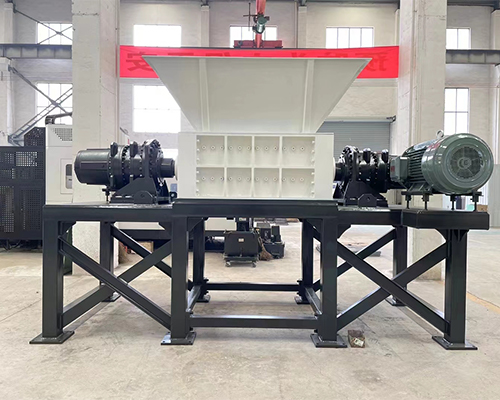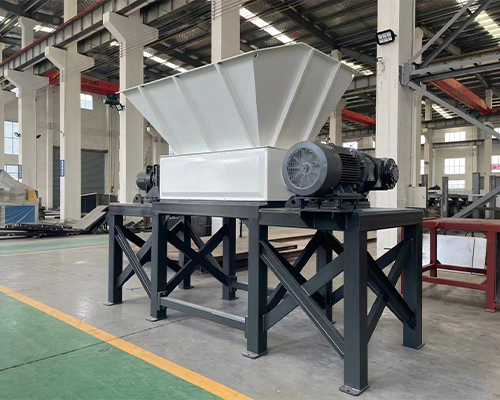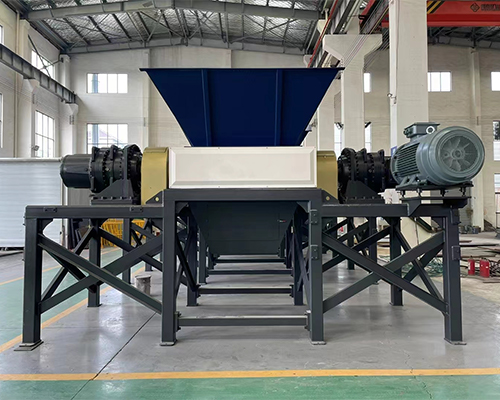Straw Double Shaft Shredder
A Straw Double Shaft Shredder is a specialized machine designed for shredding straw, agricultural waste, and other organic materials into smaller pieces for recycling or further processing. The shredder typically features two rotating shafts equipped with sharp blades or hooks that work in tandem to tear, cut, and shred the material efficiently.

Working Principle:
The double shaft design is the key feature of this shredder. It operates as follows:
- Material Feeding: Straw or other agricultural residues are fed into the shredder through a hopper.
- Dual Shaft Operation: The shredder has two parallel rotating shafts. These shafts are fitted with sharp, durable blades or hooks that rotate in opposite directions. As the shafts rotate, they engage with the straw and pull it in between the blades, tearing the material apart through a combination of shear, pressure, and friction.
- Size Reduction: The shredded straw is reduced to smaller particles as it passes through the shredder. The final particle size can be adjusted by using different screen sizes or changing the blade configuration.
Output: The shredded straw is expelled through an outlet and can be collected for further use or processing.

Key Features:
- High Efficiency: The dual-shaft mechanism allows for high-throughput, efficient shredding of large volumes of straw and other agricultural waste materials. This makes it ideal for both small and large-scale operations.
- Durability: The shredder is built with heavy-duty materials and high-quality cutting blades, ensuring it can handle tough agricultural waste without frequent wear and tear.
- Versatility: In addition to straw, these machines can shred a variety of organic materials, including grass, wood, cardboard, plastics, and other types of biomass.
- Adjustable Output Size: The particle size of the shredded material can be controlled by adjusting the screen mesh size or the gap between the two shafts. This flexibility allows the shredder to meet different processing needs, whether it's for animal feed, composting, or bioenergy production.
Energy Efficient: These machines are designed to use energy efficiently, which is an important factor in large-scale biomass recycling and waste management systems.

Applications:
- Agricultural Waste Management: The primary use of a straw double shaft shredder is for processing agricultural waste such as straw, corn stalks, and other crop residues. This reduces waste volume and makes it easier to manage and transport.
- Animal Feed Production: Shredded straw can be processed into animal feed. After shredding, it can be mixed with other ingredients to create high-quality feed for livestock.
- Bioenergy Production: The shredded straw can be used as raw material for producing biofuels, such as pellets or briquettes, for energy generation. Biomass power plants often use shredded agricultural waste as fuel for boilers.
- Composting: Shredded straw can also be used as a key ingredient in composting systems. The smaller size accelerates the decomposition process, producing high-quality organic compost for agriculture.
- Paper & Packaging Industry: Some applications also involve shredding straw to create paper or cardboard products, which are increasingly used as eco-friendly packaging materials.
Advantages:
- Efficient Waste Processing: Reduces the volume of agricultural waste significantly, making it easier to handle and transport.
- Resource Recovery: Turns agricultural waste into valuable resources such as animal feed, biofuel, or compost, promoting sustainability and circular economy practices.
- Flexible and Customizable: With adjustable output size, the machine can cater to various industries with different processing needs.
- Reduced Environmental Impact: Helps in recycling agricultural residues, which otherwise would be burned or left to decompose, reducing air pollution and supporting eco-friendly practices.
Maintenance and Care:
- Regular Blade Inspection: Check the cutting blades regularly for signs of wear and replace them when needed to maintain shredding efficiency.
- Lubrication: Keep the moving parts, especially the shafts and bearings, well-lubricated to minimize friction and wear.
- Cleanliness: Keep the machine clean by removing any debris and residue after use, as buildup can reduce efficiency and cause jams.
- Routine Checks: Periodically inspect the drive motor, electrical system, and safety components to ensure the shredder operates smoothly and safely.
Conclusion:
The Straw Double Shaft Shredder is an essential tool for the modern management of agricultural waste, particularly in large-scale farming operations. It efficiently processes straw and other organic materials into smaller, more manageable pieces, which can then be converted into valuable products like animal feed, bioenergy, or compost. Its durability, efficiency, and versatility make it a vital piece of equipment for recycling agricultural by-products and supporting sustainable farming practices.
| Model | 600 | 800 | 1000 | 1200 | 1400 | 1600 | 1800 |
| Motor(kw) | 11*2 | 18.5*2 | 35*2 | 45*2 | 55*2 | 75*2 | 110*2 |
Reducer | P6-P7 | P7-P8 | P8-P10 | P10-P12 | P11-P13 | P12-P16 | P14-P16 |
| Siemens or other motors, planetary reducers or other reducers can be customized according to customer requirements | |||||||
| Rotation Speed | 8-20rmp | 8-20rmp | 8-15rmp | 8-15rmp | 8-15rmp | 8-12rmp | 8-12rmp |
| Blades Diameter | 220-320 | 260-320 | 260-400 | 400-500 | 400-500 | 500 | 500 |
| Blades material | The material of the blades (55sicr, 5crsi, 9crsi, skd11, m6v, h13) can be customizedaccording to the customer's actual usage | ||||||
| Feeding Size | 1200*900mm | 1400*1000mm | 1600*1200mm | 1800*1300mm | 2000*1300mm | 2200*1700mm | 2400*2000mm |
| The size and appearance of the feeding hopper can be customized according to thecustomer's feeding situation | |||||||
| Weight(kg) | 1800 | 2500 | 3700 | 5500 | 7500 | 9500 | 13000 |
-
 Trommel screenTrommel screen, also known as drum screens, are widely used in various industries for sorting and separating materials.Get Quote
Trommel screenTrommel screen, also known as drum screens, are widely used in various industries for sorting and separating materials.Get Quote -
 Crop straw double shaft shreddApplications:Biomass Energy Production: Shredded straw can be used as a feedstock for bioenergy plants to produce electricity or heat.Livestock Feed: Reduced-si...Get Quote
Crop straw double shaft shreddApplications:Biomass Energy Production: Shredded straw can be used as a feedstock for bioenergy plants to produce electricity or heat.Livestock Feed: Reduced-si...Get Quote -
 Zhongcheng Air Drum SeparatorAir drum separators effectively separate lightweight materials (e.g., plastics, paper) from heavier materials (e.g., metals, glass). This high efficiency is cru...Get Quote
Zhongcheng Air Drum SeparatorAir drum separators effectively separate lightweight materials (e.g., plastics, paper) from heavier materials (e.g., metals, glass). This high efficiency is cru...Get Quote
-
2024-06-11Optimize Your Waste Management Today with Our Advanced Drum ScreensUnderstanding the Mechanism and Optimization of Drum Screens for Waste Management
-
2024-06-09Drum Screen RecyclingDrum screen machines are primarily used for material screening, helping to sort and recycle municipal solid waste and screen landfill waste. Their efficiency an...
-
2024-07-16Twin-shaft shredders: ideal for efficient processing of waste and recycling materialsA double-shaft shredder is a mechanical device used to process waste and recycle materials. Its main feature is that it has two rotating shafts with serrated bl...
-
2024-08-07Tire double shaft shredderOperation:Feeding: Whole or pre-cut tires are fed into the shredder through an inlet hopper.Shredding: As the tires enter the shredding chamber, the rotating cu...
-
2024-06-05Waste Trommel And Copmost TrommelHowever, it's important to choose the right type of drum screen based on your specific needs. Today, Kevin from Zhongcheng Company will explain the differences...



